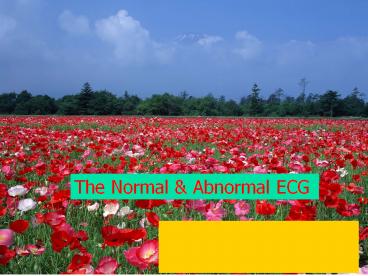EKG Interpretation - PowerPoint PPT Presentation
Title:
EKG Interpretation
Description:
The Normal & Abnormal ECG ... Accelerated Idioventricular Ventricular escape rhythm, 40-110 bpm Seen in AMI, a marker of reperfusion Junctional Rhythm Rate 40-60, ... – PowerPoint PPT presentation
Number of Views:273
Avg rating:3.0/5.0
Title: EKG Interpretation
1
The Normal Abnormal ECG
???? ?????????? ????? ? ??? ???? ??? ? ????
2
The Normal Abnormal ECG
3
Waveforms
4
All Limb Leads
5
Lead Placement
aVF
6
EKG Distributions
- Anteroseptal V1, V2, V3, V4
- Anterior V1V4
- Anterolateral V4V6, I, aVL
- Lateral I and aVL
- Inferior II, III, and aVF
- Inferolateral II, III, aVF, and V5 and V6
7
Rhythm
- Sinus
- Originating from SA node
- P wave before every QRS
- P wave in same direction as QRS
8
What is this rhythm?
- Normal sinus rhythm
9
What is the heart rate?
www.uptodate.com
300 / 6 50 bpm 1500 / 30 50
10
The QRS Axis
- Represents the overall direction of the hearts
activity - Axis of 30 to 90 degrees is normal
11
The Quadrant Approach
- QRS up in I and up in aVF Normal
12
Normal Intervals
- PR
- 0.20 sec (less than one large box)
- QRS
- 0.08 0.10 sec (1-2 small boxes)
- QT
- 450 ms in men, 460 ms in women
- Based on sex / heart rate
- Half the R-R interval with normal HR
13
RHYTHEM
- HR Bradycardia or tachycardia
- Pause
- Premature beat
- blocks
14
What is this rhythm?
15
What is this rhythm?
16
Premature Atrial Contractions
Trigeminy pattern
17
What is this rhythm?
18
What is this rhythm?
19
Tachyarrhythmia
- Regular
- Narrow QRS
- Wide QRS VT or SVT aberrancy
- Irregular- irregular
- AF
- MAT
20
21
Supraventricular Tachycardia
Retrograde P waves
Narrow complex, regular retrograde P waves, rate
lt220
22
Ventricular Tachycardia
23
What is this rhythm?
24
What is this rhythm?
25
What is this rhythm?
26
What is this rhythm?
27
What is this rhythm?
28
What is this rhythm?
29
Accelerated Idioventricular
Ventricular escape rhythm, 40-110 bpm Seen in
AMI, a marker of reperfusion
30
Junctional Rhythm
Rate 40-60, no p waves, narrow complex QRS
31
AV- Blocks
- AV blocks
- First degree block
- PR interval fixed and gt 0.2 sec
- Second degree block, Mobitz type 1
- PR gradually lengthened, then drop QRS
- Second degree block, Mobitz type 2
- PR fixed, but drop QRS randomly
- Type 3 block
- PR and QRS dissociated
32
What is this rhythm?
- First degree AV block
PR is fixed and longer than 0.2 sec
33
What is this rhythm?
34
First Degree Heart Block
PR interval gt200ms
35
What is this rhythm?
- Type 1 second degree block (Wenckebach)
36
What is this rhythm?
37
First Degree Heart Block, Mobitz Type I
(Wenckebach)
PR progressively lengthens until QRS drops
38
What is this rhythm?
- Type 2 second degree AV block
39
What is this rhythm?
40
Second Degree Heart Block, Mobitz Type II
PR interval fixed, QRS dropped intermittently
41
What is this rhythm?
- 3rd degree heart block (complete)
42
What is this rhythm?
43
Bundle branch block
- RBBB
- LBBB
44
Left Bundle Branch Block
Monophasic R wave in I and V6, QRS gt 0.12
sec Loss of R wave in precordial leads QRS T wave
discordance I, V1, V6 Consider cardiac ischemia
if a new finding
45
Right Bundle Branch Block
V1 RSR prime pattern with inverted T wave V6
Wide deep slurred S wave
46
Ischemia MI
47
What do you see in this EKG?
- ST depression II, III, aVF, V3-V6 ischemia
48
What is the diagnosis?
- Acute inferior MI with ST elevation in
leads II, III, aVF
49
Wellens Sign
ST elevation and biphasic T wave in V2 and
V3 Sign of large proximal LAD lesion
50
Lateral MI
Reciprocal changes
51
Inferolateral MI
ST elevation II, III, aVF ST depression in aVL,
V1-V3 are reciprocal changes
52
Anterolateral / Inferior Ischemia
LVH, AV junctional rhythm, bradycardia
53
Right Ventricular Myocardial Infarction
Found in 1/3 of patients with inferior
MI Increased morbidity and mortality ST elevation
in V4-V6 of Right-sided EKG
54
(No Transcript)
55
Hyperkalemia
Tall, narrow and symmetric T waves
56
Brugada Syndrome
RBBB or incomplete RBBB in V1-V3 with convex ST
elevation
57
Atrial Flutter with Variable Block
Sawtooth waves Typically at HR of 150
58
Torsades de Pointes
Notice twisting pattern Treatment Magnesium 2
grams IV
59
Digitalis
Dubin, 4th ed. 1989
60
Prolonged QT
QT gt 450 ms Inferior and anterolateral ischemia
61
Acute Pulmonary Embolism
SIQIIITIII in 10-15 T-wave inversions,
especially occurring in inferior and
anteroseptal simultaneously RAD
62
Wolff-Parkinson-White Syndrome
Short PR interval lt0.12 sec Prolonged QRS gt0.10
sec Delta wave Can simulate ventricular
hypertrophy, BBB and previous MI
63
(No Transcript)

